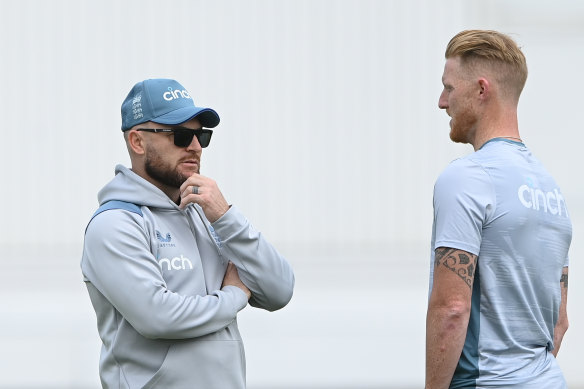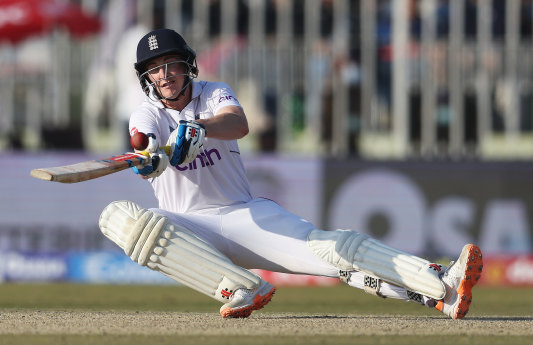
“Because of the depth of white ball cricket in the UK, and the large scale of the Hundred, the IPL and other tournaments, these guys are used to performing under pressure and getting out. So now it’s ‘I’m going to take the game on’ and the risks aren’t as high as they look. They’re just playing to their strengths.”

England celebrate a remarkable Test victory after the last Pakistan wicket falls.Credit:Getty Images
As the graph below shows, England’s run rate under McCullum is consistently higher than the average in Tests for the same period (and the average of four runs per over itself is historically high as it includes England’s motoring rate in Rawalpindi and Australia’s short chase in Sri Lanka).
McCullum’s breakthrough moment arrived in the wake of Phillip Hughes’ awful death in November 2014. New Zealand were playing Pakistan in the UAE and did not want to carry on. After speaking with the psychologist Gilbert Enoka, McCullum counselled his team to abandon all their previous ideas on how to play or prepare.
“The outcome of the ‘uncaring’, no-consequence play was a revelation to me,” McCullum said in his 2016 Cowdrey Lecture. “I suspect it was something I had been trying to achieve on a personal level for years; but I had been unable to do so, except for fleeting moments. Here there was a release of many of the external factors that can creep in and influence a player. There was an instinctiveness that took over – no fear of failure, just playing and being ‘in the moment’.”
What followed was a huge score of 690 made at nearly five an over, 22 sixes, and a win almost as seismic as this one on a dead surface. Viewed that way, it is understandable that McCullum, Stokes and England do not see this as playing a risky game.

Brendon McCullum and Ben Stokes.Credit:Getty Images
“With ‘Baz’, this isn’t about forcing change or creating a legacy, this is just what he believes in,” Woodhill said. “His mantra is that if you’re overly positive and aggressive, you’re going to have more luck and things go your way.
“Baz doesn’t actually see this as taking risks or chances. He has an unwavering belief that being positive and aggressive is the way to play. You’re going to have to counterpunch against this team, because they’ll come out swinging and get you on the ropes. So it’s how teams deal with it.
“When that scoreboard starts to tick over, self-doubt always appears in the opposition. That’s the beauty of this team – a fielding side takes a wicket and thinks, OK, we can reset for a few overs – but the next guy is all of a sudden 30 off 28 and there’s a partnership of 50 off 45 balls and you think ‘how did that happen?’”
England’s performances have expanded the range of broadly acceptable possibilities for Test cricket, much as Holland did for football in the 1970s, by making the most of the rising skills of batting in the shorter formats and taking that back to red ball games.
In England’s second innings in Rawalpindi, former captain Joe Root switched to a left-handed batting stance for two balls as the leg-spinner Zahid Mahmood was bowling into the rough on his pads.
Root might have gone viral for his exploits, but the dramatic uplift has come from younger teammates: Zak Crawley doing what England hoped he would, Harry Brook going for Test bowling with the same vigour he’s shown in Twenty20, and Ollie Pope looking twice the player who floundered in the Ashes last summer.
“There’s always that cycle of change,” Woodhill said. “We saw it with the Australian team of 2001 with Hayden at the top and Gilchrist at seven and chasing the game a bit more. I think there’s now more white ball cricket played where strike rates of a hundred or more are the norm rather than the exception, and that’s carrying over.
“Then there was England at Edgbaston scoring 400 in a day in 2005, and the pace of play they went at sent a message to the Australian team that these guys are playing without fear.
“We’ve seen innings from Dave Warner, Travis Head has played some the same where they’ve attacked the bowling. But because it’s becoming more acceptable, more are going to take it on.”
In the aftermath of England’s victory, secured as the light faded in Rawalpindi, Stokes returned to another theme, that of making Test cricket as watchable as possible.
“We’re going to play to win every game out here and if we find ourselves in the same position in game two, we’ll be doing exactly the same kind of thing,” Stokes said. “We don’t want Test cricket to fall off the face of the planet. It needs to stay around and we’ll do everything we can to keep it alive.
“That’s what we are trying to do as a team – to make Test cricket as exciting as the shorter formats. The way the batters went out there with freedom and enjoyment allowed us to be where we were on day five. And also the willingness of the bowlers to experiment with different plans and fields. We had to be unconventional to take 20 wickets.

Harry Brook made 153 from 116 balls in the first inningsCredit:Getty Images
Loading
“We wanted the game to be in a position where every over you just didn’t know what was going to happen. It’s a lot more exciting to watch, and to play in, knowing there is something to play for. We managed to take the last wicket with eight minutes left, something like that. Who doesn’t want to watch a Test match being played like that?”









 Add Category
Add Category